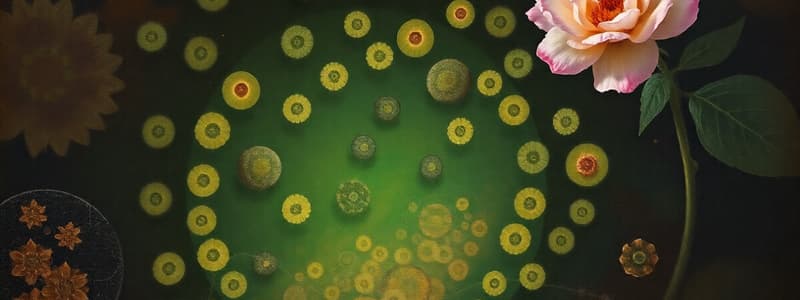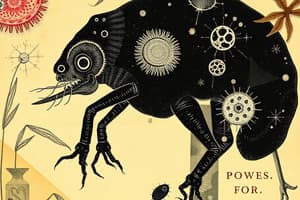Podcast
Questions and Answers
Which of the following correctly lists the ecological levels of organization?
Which of the following correctly lists the ecological levels of organization?
- Individuals, communities, ecosystems, populations
- Individuals, populations, communities, ecosystems (correct)
- Communities, ecosystems, populations, individuals
- Populations, individuals, ecosystems, communities
Which key ecological concept describes a relationship where both species benefit?
Which key ecological concept describes a relationship where both species benefit?
- Mutualism (correct)
- Competition
- Predation
- Commensalism
Which physiological regulation process helps maintain internal stability in organisms?
Which physiological regulation process helps maintain internal stability in organisms?
- Homeostasis (correct)
- Photosynthesis
- Metabolism
- Growth
What is the primary focus of microbiology?
What is the primary focus of microbiology?
Which application is NOT typically associated with biotechnology?
Which application is NOT typically associated with biotechnology?
Which classification level is the broadest?
Which classification level is the broadest?
What type of cells lack membrane-bound organelles?
What type of cells lack membrane-bound organelles?
Which process is essential for gene expression?
Which process is essential for gene expression?
Natural selection is best described as:
Natural selection is best described as:
What is the basic unit of life in all organisms?
What is the basic unit of life in all organisms?
Which of the following is NOT a characteristic used for classification of organisms?
Which of the following is NOT a characteristic used for classification of organisms?
Which scientific method is commonly used in biological research?
Which scientific method is commonly used in biological research?
Flashcards
Biology
Biology
The scientific study of life and living organisms.
Classification of Living Organisms
Classification of Living Organisms
Grouping living things based on shared traits.
Cell
Cell
The basic unit of life.
Prokaryotic cell
Prokaryotic cell
Signup and view all the flashcards
Genetics
Genetics
Signup and view all the flashcards
Evolution
Evolution
Signup and view all the flashcards
Natural Selection
Natural Selection
Signup and view all the flashcards
Ecology
Ecology
Signup and view all the flashcards
Ecological Levels
Ecological Levels
Signup and view all the flashcards
Biodiversity
Biodiversity
Signup and view all the flashcards
Physiology
Physiology
Signup and view all the flashcards
Microbiology
Microbiology
Signup and view all the flashcards
Biotechnology
Biotechnology
Signup and view all the flashcards
Study Notes
Introduction to Biology
- Biology is the scientific study of life and living organisms.
- It encompasses a vast range of topics, from the smallest molecules within cells to the largest ecosystems on Earth.
- Key concepts include evolution, genetics, ecology, and physiology.
- Biology employs scientific methods to investigate questions about life, including observation, experimentation, and data analysis.
Classification of Living Organisms
- Living organisms are classified into different groups based on shared characteristics.
- The broadest classification levels are domain, kingdom, phylum, class, order, family, genus, and species.
- The current system, primarily based on evolutionary relationships, uses phylogenetic trees to illustrate these relationships.
- Key characteristics used for classification include cellular structure, genetic makeup, mode of nutrition, morphology (physical features), and evolutionary relationships.
Cell Biology
- The cell is the basic unit of life for all living organisms.
- There are two primary types of cells: prokaryotic and eukaryotic.
- Prokaryotic cells are typically smaller and simpler, lacking membrane-bound organelles.
- Eukaryotic cells are larger and more complex, containing membrane-bound organelles like the nucleus, mitochondria, and endoplasmic reticulum.
- Cellular processes like respiration, photosynthesis, and protein synthesis occur within the cell.
Genetics
- Genetics deals with heredity and the mechanisms of inheritance.
- Genes, segments of DNA, carry the genetic information required for an organism’s traits.
- DNA (deoxyribonucleic acid) is the primary genetic material in most organisms.
- DNA replication, transcription, and translation are crucial processes for gene expression.
- Mutations in DNA can lead to variations in traits.
Evolution
- Evolution is the change in heritable characteristics of biological populations over successive generations.
- Natural selection is a key mechanism of evolution.
- Natural selection describes how organisms with traits better suited to their environment are more likely to survive and reproduce.
- Adaptations are traits that enhance an organism's survival or reproduction in its environment.
- Evidence for evolution comes from different sources, including fossils, comparative anatomy, molecular biology, and biogeography.
Ecology
- Ecology studies the interactions between organisms and their environment.
- Ecological levels of organization include individuals, populations, communities, and ecosystems.
- Key ecological concepts include competition, predation, symbiosis (mutualism, commensalism, parasitism), and energy flow.
- Biodiversity refers to the variety of life at all levels of organization and is crucial to healthy ecosystems.
Physiology
- Physiology studies the functions of living organisms and their parts.
- This includes the chemical and physical processes within organisms.
- Examples include how organisms obtain and use energy, maintain internal stability (homeostasis), and reproduce.
- Different physiological systems work in interconnected ways to maintain life.
Microbiology
- Microbiology examines microscopic organisms, including bacteria, viruses, fungi, and protists.
- These organisms play crucial roles in various ecosystems and impact human health.
- Fundamental processes of microbiology encompass microbial metabolism, growth, reproduction, and interactions with other organisms.
- Viruses are obligate intracellular pathogens, relying on the host cell machinery for replication.
Biotechnology
- Biotechnology involves using living organisms or their products for technological applications.
- Key areas of biotechnology include genetic engineering, recombinant DNA technology, and bioremediation.
- DNA technology allows specific changes in genetic makeup of organisms.
- Biotechnology has applications in medicine, agriculture, and industry.
Studying That Suits You
Use AI to generate personalized quizzes and flashcards to suit your learning preferences.




